The company we now know as Omega wasn’t always called that. Omega wasn’t what they were called, it was what they made. This is a true story.
In 1894, 15 years after the Brandt brothers Louis-Paul and César took over the company that their father had established in 1848, they launched a new pocket watch movement, the Omega calibre. This new movement was distinguished by two things — its industrial design and construction, allowing watchmakers to replace components easily, and its reliable performance. At a time when watches were usually a compromise between efficient production and high performance, a movement that accomplished both without sacrificing either naturally became the top choice for watch companies. The Omega calibre became so popular that its status eventually eclipsed everything else made by Louis Brandt & Frère. Louis-Paul and César officially made “Omega Watch & Co.” part of the registered company name in 1903.

Perhaps Louis-Paul and César always knew that the Omega calibre would become the future of Louis Brandt & Frère. You don’t name something “Omega” — with its connotations of finality and ultimacy — when you know there’s something better coming in two months. They were right. To this day, the most prized values of an Omega watch are its performance and its production efficiency, striking that balance of prestige and pragmatism that is so loved by the company’s aficionados.
In celebration of this landmark calibre, Omega has recreated its eponymous movement, casing it in a pocket watch that incorporates some of the brand’s more recent innovations. For example, the bi-metal case is formed out of red Sedna Gold (case lids) and white Canopus Gold (case middle), both proprietary alloys of Omega that were developed to maximise the impact and integrity of their colour.
The overall design of the watch is reflective of the early 20th century, an acknowledgement of the era in which the Omega calibre was launched. Details exemplifying this include the numerals for time indication and the style of the winding/setting crown and bow, not to mention the damaskeened decoration on the movement plates and bridges. On the multi-tiered grand feu enamel dial, the antique Omega logo can be seen at the 12 o’clock position.

Even when the pocket watch is shut, the time can be read thanks to a circular aperture in the centre of the Sedna-gold lid. The exterior of the case is ilaid with red enamel, marking out a second set of hour indices on the front lid and additional damaskeening on the case middle.
What truly makes this pocket watch a part of history whilst still being a modern creation is that many of the movement parts are sourced directly from stores of spare components of the Omega calibre, over a century old. These are supplemented with some modern parts in order to be able to complete the movement, though great care was taken to reproduce them in exactly the same form and style as the original. Only 19 pocket watches will be made in total, a number that pays homage to the dimensions of the 19-ligne calibre.






